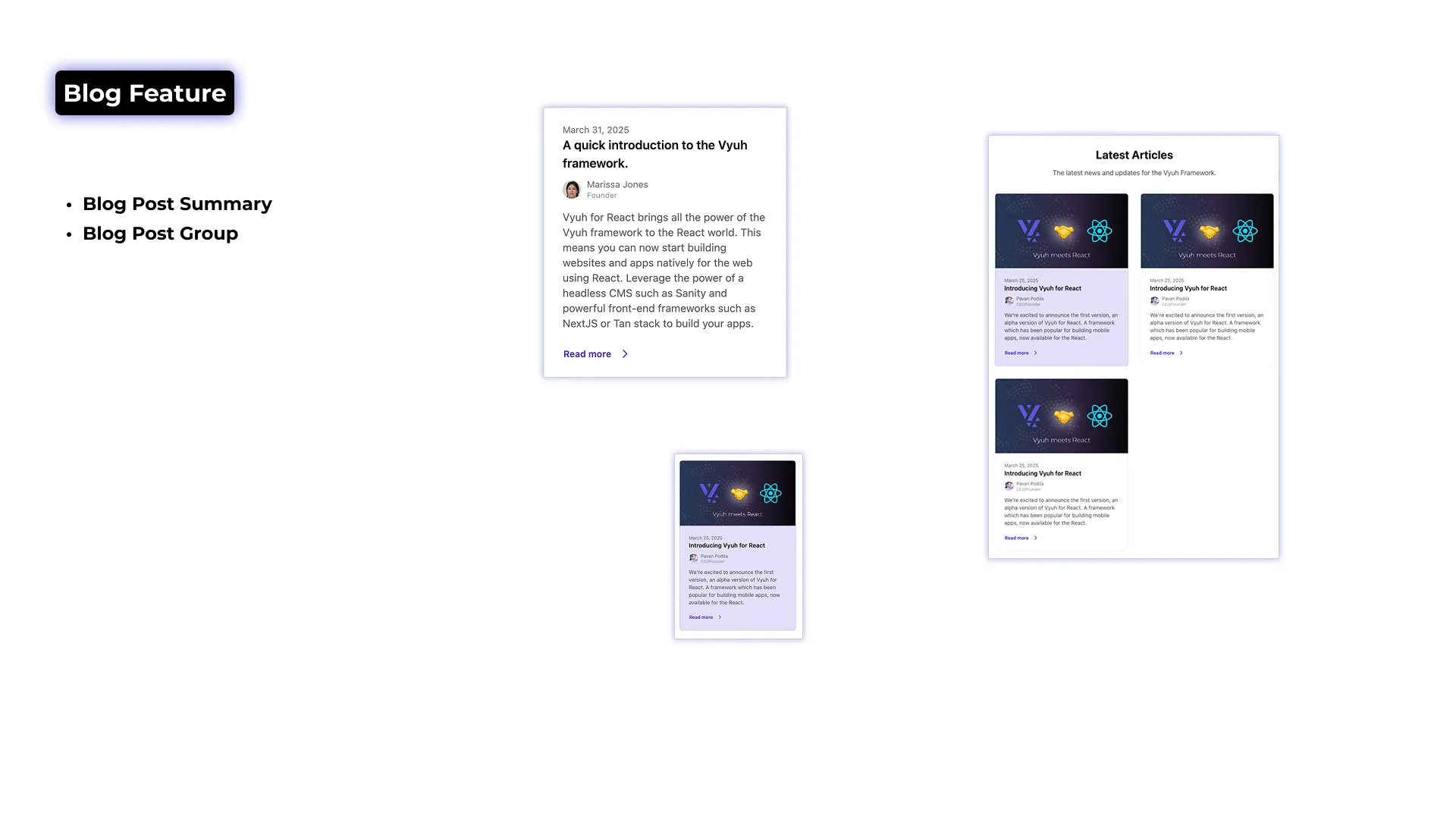Blog Feature
The blog feature provides content types and components for building blog sections and displaying blog posts. It’s designed to work seamlessly with the Vyuh framework’s content system, allowing you to create rich, interactive blog experiences.

Content Types
Section titled “Content Types”The blog feature includes several content types for building blog sections and displaying blog content. Here’s the complete list of content types provided by the blog feature:
- Blog Post Summary - Individual blog post previews with metadata
- Blog Group - Collections of blog posts for display
- Blog Post - Full blog post content (under construction)
- Blog Category - Category definitions for organizing posts (under construction)
- Blog Author - Author profiles for blog posts (under construction)
We’ll cover the two main content types in detail below, but you can explore the full source code on GitHub for more information about the other content types.
You can explore the full source code for the blog feature on GitHub:
You can also view the complete blog feature directory 🔗 in the Vyuh repository.
Blog Post Summary
Section titled “Blog Post Summary”The BlogPostSummary content type represents an individual blog post with metadata:
// Blog post summary content structureinterface BlogPostSummary extends ContentItem { // The title of the blog post readonly title: string
// A short summary of the post readonly excerpt?: string
// Featured image for the blog post readonly image?: ImageReference
// Publication date of the blog post readonly date?: string
// Author information readonly author?: { readonly name?: string readonly role?: string readonly avatar?: ImageReference }
// Categories or tags for the blog post readonly categories?: string[]
// Whether this post should be featured readonly featured?: boolean
// Link to the full post readonly action?: Action}Blog post summaries are used to display previews of blog posts in lists, grids, or featured sections.
Blog Group
Section titled “Blog Group”The BlogGroup content type represents a collection of blog posts:
// Blog group content structureinterface BlogGroup extends ContentItem { // The main title for the blog section readonly title: string
// A supporting text that appears below the title readonly subtitle?: string
// Blog posts to display in the section readonly posts: { readonly title: string readonly excerpt?: string readonly image?: ImageReference readonly date: string readonly author?: { readonly name: string readonly role?: string readonly avatar?: ImageReference } readonly categories?: string[] readonly featured?: boolean readonly action: Action }[]
// Optional call-to-action button (e.g., "View all posts") readonly action?: Action}Blog groups are used to display collections of blog posts, such as recent posts, featured posts, or category-specific posts.
Implementation Structure
Section titled “Implementation Structure”Sanity Studio Side
Section titled “Sanity Studio Side”In Sanity Studio, the blog feature is defined with content descriptors and schema builders:
// Blog feature descriptor for Sanityexport const blog = new FeatureDescriptor({ name: 'blog', title: 'Blog', description: 'Schema for Blog components including posts and post groups',
// Content descriptors define available content types contents: [ new BlogGroupDescriptor({ layouts: [defaultBlogGroupLayout], }), new RouteDescriptor({ regionItems: [ { type: BlogGroupDescriptor.schemaName }, { type: BlogPostSummaryDescriptor.schemaName }, ], }), ],
// Schema builders generate Sanity schemas contentSchemaBuilders: [ new BlogPostSchemaBuilder(), new BlogGroupSchemaBuilder(), ],})The BlogPostSchemaBuilder defines the schema for blog posts:
// Blog post schema builderexport class BlogPostSchemaBuilder extends ContentSchemaBuilder { private schema = defineType({ name: 'blog.post.summary', title: 'Blog Post Summary', type: 'object', icon: Icon, fields: [ defineField({ name: 'title', title: 'Post Title', type: 'string', validation: (Rule) => Rule.required(), }), defineField({ name: 'excerpt', title: 'Excerpt', type: 'text', description: 'A short summary of the post', }), // More fields... ], // Preview configuration... })
constructor() { super(BlogPostSummaryDescriptor.schemaName) }
build(descriptors: ContentDescriptor[]) { return this.schema }}React Side
Section titled “React Side”In the React application, the blog feature is defined with content builders that render the content:
// Blog feature descriptor for Reactexport const blog = new FeatureDescriptor({ name: 'blog', title: 'Blog', description: 'Blog components for building Blog pages', icon: <Icon />,
extensions: [ new ContentExtensionDescriptor({ // Content builders render the content contentBuilders: [ new BlogGroupContentBuilder(), new BlogPostSummaryContentBuilder(), ], }), ],});The BlogPostSummaryContentBuilder defines how blog posts are rendered:
// Blog post content builderexport class BlogPostSummaryContentBuilder extends ContentBuilder<BlogPostSummary> { constructor() { super({ schemaType: BLOG_POST_SUMMARY_SCHEMA_TYPE, defaultLayout: new DefaultBlogPostSummaryLayout(), defaultLayoutDescriptor: DefaultBlogPostSummaryLayout.typeDescriptor, }) }}Components
Section titled “Components”The blog feature includes several React components for rendering blog content:
BlogPostCard
Section titled “BlogPostCard”The BlogPostCard component renders a blog post summary as a card:
export const BlogPostCard: React.FC<BlogPostCardProps> = ({ content, className,}) => { const { getImageUrl } = useMediaUtils()
// Format date to a readable string const formatDate = (dateString: string | undefined) => { if (!dateString) return null const date = new Date(dateString) return new Intl.DateTimeFormat('en-US', { year: 'numeric', month: 'long', day: 'numeric', }).format(date) }
return ( <div className={cn( 'flex flex-col overflow-hidden rounded-lg transition-all hover:shadow-md', content.featured ? 'bg-primary/15 border-primary/20 border' : 'bg-base-100 border-base-300 border', 'cursor-pointer', className, )} onClick={() => executeAction(content.action)} > {/* Featured image */} {content.image && ( <div className="aspect-video overflow-hidden"> <img src={getImageUrl(content.image)} alt={content.title} className="h-full w-full object-cover" /> </div> )}
{/* Card content */} <div className="flex flex-1 flex-col p-4"> {/* Title, author, date, excerpt, etc. */} </div> </div> )}The blog feature provides a complete solution for building blog sections in your application. Content creators can use Sanity Studio to create and manage blog posts, while developers can use the React components to render those posts in the application.
The blog feature works well with the marketing feature for creating complete websites with both marketing pages and blog content.

